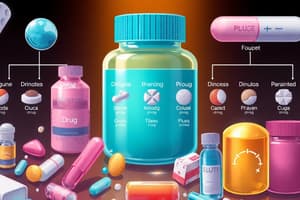Podcast
Questions and Answers
What is the primary source of alkaloids?
What is the primary source of alkaloids?
- Endocrine glands
- Fungi
- Plants (correct)
- Amino acids
Which classification of drugs is based on the natural source of the drugs?
Which classification of drugs is based on the natural source of the drugs?
- Based on chemical structure (correct)
- Based on therapeutic use
- Based on mechanism of action
- Based on pharmacological action
Which of the following drugs is an example of an antiviral?
Which of the following drugs is an example of an antiviral?
- Penicillin
- Lidocaine
- Acyclovir (correct)
- Dopamine
What is the primary function of anesthetics?
What is the primary function of anesthetics?
What is the primary function of antihistamines?
What is the primary function of antihistamines?
Which classification of drugs is based on the specific disease or condition they are used to treat?
Which classification of drugs is based on the specific disease or condition they are used to treat?
What is the primary function of receptor agonists?
What is the primary function of receptor agonists?
Which classification of drugs is based on how they work at the molecular level?
Which classification of drugs is based on how they work at the molecular level?
Study Notes
Classification of Drugs in Pharmacology
Based on Chemical Structure
- Alkaloids: Derived from plants, contain nitrogenous bases (e.g., morphine, codeine, atropine)
- Glycosides: Derived from plants, contain sugar molecules (e.g., digoxin, ouabain)
- Amino Acids: Derived from amino acids, used as neurotransmitters or hormones (e.g., dopamine, thyroxine)
- Hormones: Derived from endocrine glands, regulate various bodily functions (e.g., insulin, thyroxine)
Based on Pharmacological Action
- Antibacterials: Inhibit or kill bacteria (e.g., penicillin, tetracycline)
- Antivirals: Inhibit or kill viruses (e.g., acyclovir, oseltamivir)
- Antifungals: Inhibit or kill fungi (e.g., fluconazole, amphotericin B)
- Anesthetics: Cause numbness or loss of sensation (e.g., lidocaine, propofol)
- Analgesics: Relieve pain (e.g., aspirin, morphine)
- Antihistamines: Counteract histamine effects (e.g., diphenhydramine, loratadine)
Based on Therapeutic Use
- Cardiovascular Drugs: Treat heart and blood vessel disorders (e.g., beta blockers, ACE inhibitors)
- Antineoplastic Drugs: Treat cancer (e.g., chemotherapy, immunotherapy)
- Psychotropic Drugs: Treat mental health disorders (e.g., antidepressants, antipsychotics)
- Anti-Inflammatory Drugs: Reduce inflammation (e.g., NSAIDs, corticosteroids)
Based on Mechanism of Action
- Receptor Agonists: Bind to receptors, mimicking natural ligands (e.g., dopamine agonists, adrenergic agonists)
- Receptor Antagonists: Bind to receptors, blocking natural ligands (e.g., beta blockers, antihistamines)
- Enzyme Inhibitors: Inhibit enzyme activity (e.g., ACE inhibitors, MAOIs)
- Channel Modulators: Affect ion channel function (e.g., calcium channel blockers, potassium channel openers)
Classification of Drugs in Pharmacology
Based on Chemical Structure
- Alkaloids are derived from plants and contain nitrogenous bases, examples include morphine, codeine, and atropine.
- Glycosides are derived from plants and contain sugar molecules, examples include digoxin and ouabain.
- Amino Acids are derived from amino acids and are used as neurotransmitters or hormones, examples include dopamine and thyroxine.
- Hormones are derived from endocrine glands and regulate various bodily functions, examples include insulin and thyroxine.
Based on Pharmacological Action
- Antibacterials inhibit or kill bacteria, examples include penicillin and tetracycline.
- Antivirals inhibit or kill viruses, examples include acyclovir and oseltamivir.
- Antifungals inhibit or kill fungi, examples include fluconazole and amphotericin B.
- Anesthetics cause numbness or loss of sensation, examples include lidocaine and propofol.
- Analgesics relieve pain, examples include aspirin and morphine.
- Antihistamines counteract histamine effects, examples include diphenhydramine and loratadine.
Based on Therapeutic Use
- Cardiovascular Drugs treat heart and blood vessel disorders, examples include beta blockers and ACE inhibitors.
- Antineoplastic Drugs treat cancer, examples include chemotherapy and immunotherapy.
- Psychotropic Drugs treat mental health disorders, examples include antidepressants and antipsychotics.
- Anti-Inflammatory Drugs reduce inflammation, examples include NSAIDs and corticosteroids.
Based on Mechanism of Action
- Receptor Agonists bind to receptors, mimicking natural ligands, examples include dopamine agonists and adrenergic agonists.
- Receptor Antagonists bind to receptors, blocking natural ligands, examples include beta blockers and antihistamines.
- Enzyme Inhibitors inhibit enzyme activity, examples include ACE inhibitors and MAOIs.
- Channel Modulators affect ion channel function, examples include calcium channel blockers and potassium channel openers.
Studying That Suits You
Use AI to generate personalized quizzes and flashcards to suit your learning preferences.
Description
Classify drugs based on their chemical structure and pharmacological effects. Learn about alkaloids, glycosides, amino acids, and hormones in this quiz.




